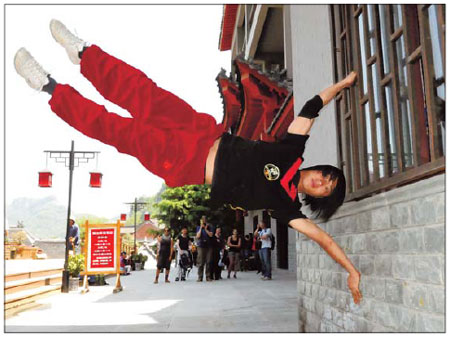Parkour, it's totally cooooool
By Xu Lin ( China Daily )
Updated: 2011-05-14
|
How's it hanging? Gao Jiawen, 21, of Maoming city in South China's Guangdong province, does parkour in the Wudang Mountains in Central China's Hubei province on April 24. Xu Lin / China Daily |
Meeting of extreme sport and kungfu mixes flight with fight
SHIYAN, Hubei - A pack of hipsters in T-shirts and monks in robes leap from a temple roof and pose in midair.
Landing on the ground with catlike grace, they bolt toward a red wall, run up its horizontal surface and do backflips.
You could be forgiven for thinking it's a scene out of an action movie.
In fact, the acrobatic display was put on by a mix of kungfu masters and practitioners of the extreme sport of parkour, which was part of preparations for the second Red Bull National Parkour Tournament in the home of kungfu in the Wudang Mountains in Central China's Hubei province. The tournament ended in Beijing early this month.
The goal of parkour, which originated in France in the 1980s, is to quickly and efficiently navigate an obstacle course using showy stunts such as leaping, climbing, rolling and swinging.
"Running, jumping and somersaulting are also the basic movements of Chinese martial arts," said kungfu master Zhong Yunlong, of Wudang Mountains' Sanfeng Faction.
"But kungfu is about fighting, while parkour is about fleeing," he said. "I believe it's a good thing and can generate more interest in kungfu."
The event in late April brought 10 of the nimblest Chinese parkour athletes, known as traceurs, to train with the world's top team - Yamakasi - and to teach the sport to Taoist monks.
Tu Fenghao, a member of Beijing's City Monkey Parkour Club, which has won the top three national awards, learned about the sport when he saw the French film Yamakasi seven years ago. He was inspired by the movie, which is loosely based on the true story of the world's best team.
"I got up at 6 am every day to watch the movie and imitate the moves," said the 22-year-old.
Two years later, his mother gave him a digital video camera for his birthday. He filmed his daily practices and posted the footage online.
Since the first official parkour clubs started in China in 2006, the number of practitioners has grown to about 200,000, along with about 200 clubs.
Tu said he did stunt biking for five years before taking up parkour.
"I love parkour because I can fly on my own without any equipment like a bike," he said.
"Traceurs don't fear difficulties in training or in life."
Gao Jiawen said the sport has taught him "confidence, carefulness and patience".
"Parkour makes me feel free, especially when I reach the peak of a jump," said the 21-year-old native of Maoming city in South China's Guangdong province.
Most traceurs learn by imitating online videos, and the Internet enables aficionados to connect.
Tu said he has met several traceurs online from his hometown of Baoding in Hebei province.
"We started to train together systematically. And it was only by doing parkour together that we discovered the importance of warming up."
Tu decided to pursue parkour rather than a university degree after high school - a decision his parents neither support nor oppose. In 2008, he began regularly visiting Beijing to develop his career, because the capital hosts the country's most active parkour scene.
"I spend 45 yuan ($7) and about an hour every week to take a train to Beijing, where I stay at my friend's house," he said.
"That way, I can save money for my career, because the rent and daily necessities are so expensive in Beijing."
Tu has invested 100,000 yuan ($15,400) in the club - money earned by performances and financial support from his parents. City Monkey's 400 members are aged between 17 and 22.
Like most parkour clubs, the group makes money by providing stunt services for film and TV, and by training fans.
His income is usually between 2,000 yuan and 3,000 yuan a month.
Tu explained there are occupational hazards, such as injuries.
"Traceurs have to be very careful," he said.
"I always wipe the dust off the rails and check the landing sites."
Gao said injuries are common. He spent two months bedridden after landing on his side during a 2-meter-high jump.
"Every time I get hurt, I take notes about what happened so I don't repeat the mistake," he said.
After completing a year of university, Gao dropped out in 2010 to fully devote himself to parkour. He said the two greatest challenges to the sport's development in a city as small as Maoming are a lack of public awareness and a shortage of funding.
"Many people tell me it's dangerous. But it's safe, as long as you're careful," he said.
Anywhere with obstacles - gyms, parks, schools - can become a training ground. Passers-by often mistake parkour performers for burglars or acrobats, Gao said.
"My club isn't making money yet, because we haven't received any performance invitations," he said.
"I can't even rent an indoor training facility. All I have to live off is 600 yuan a month from my father."
While Maoming residents don't know about parkour yet, Gao still has high hopes.
"My greatest dream is to open a parkour school here," he said. "I'm sure I can do it."
China Daily
(China Daily 05/14/2011 page1)




